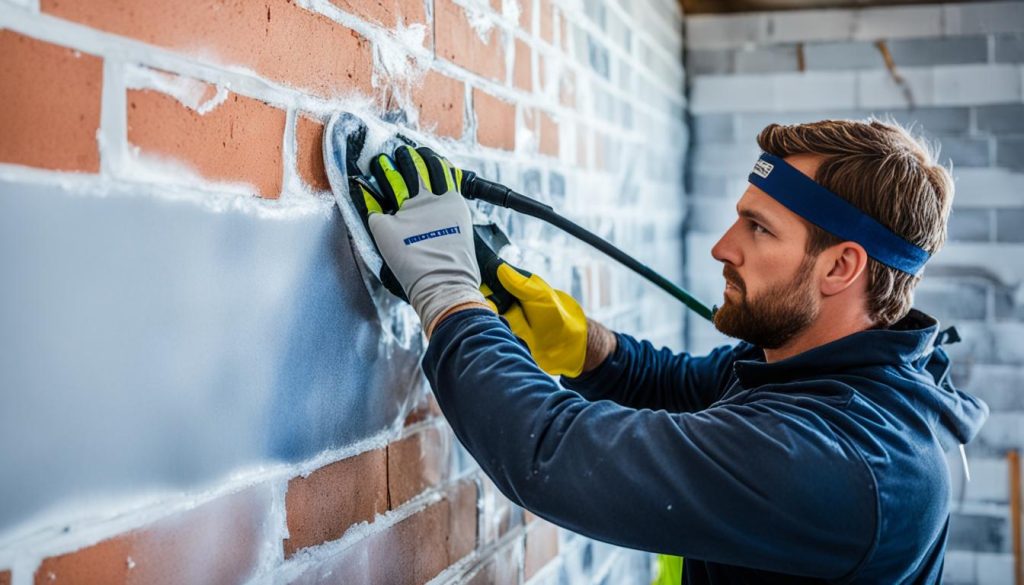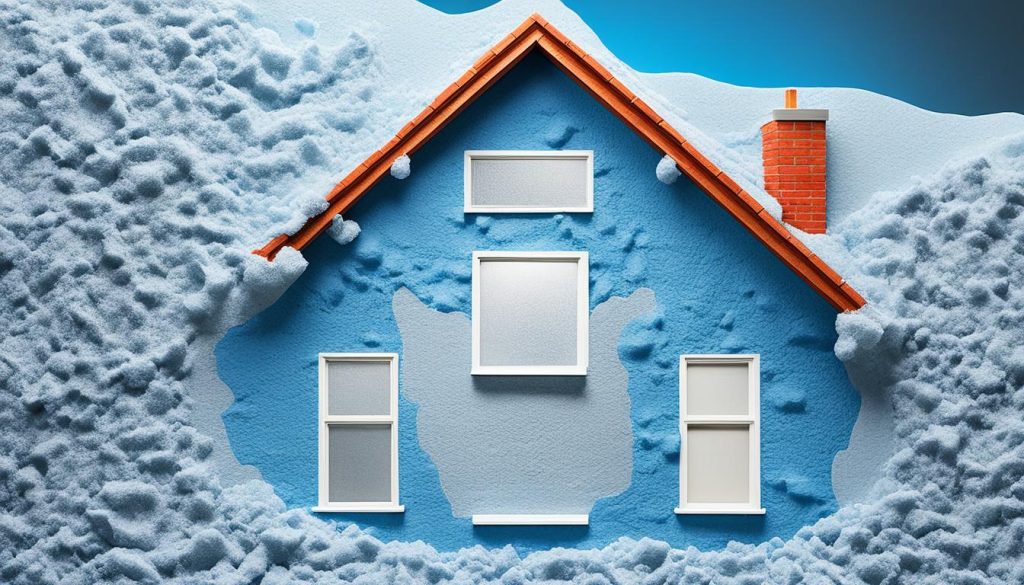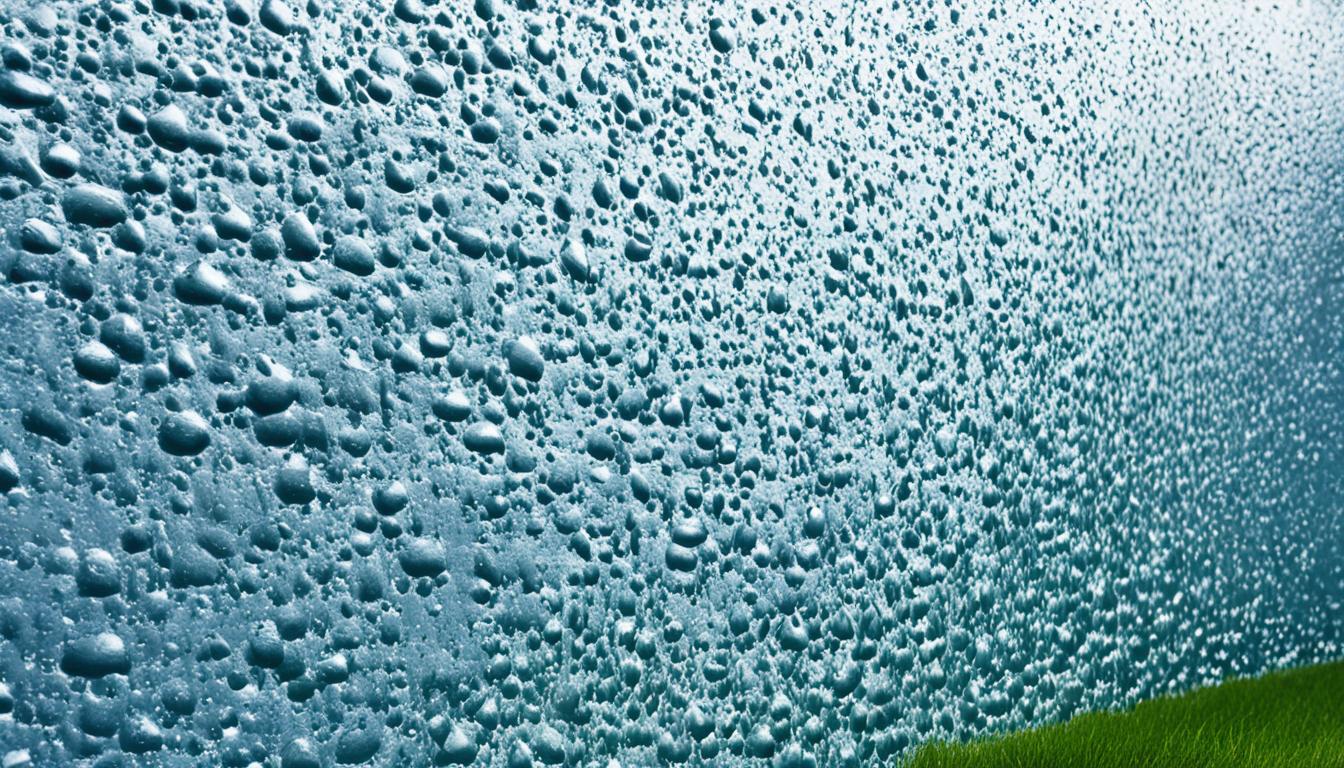Did you know that excess moisture in the home can lead to mold growth, corrosion of metal surfaces, wood rot, and pest infestations? It’s a common issue that can cause significant damage to your property and compromise your family’s health. But there’s a solution that can help minimize these problems and protect your home: moisture barriers for walls.
Moisture barriers, also known as wall moisture barriers or wall vapor barriers, are essential for preventing moisture buildup and keeping your walls dry and healthy. These barriers control the permeability of moisture in a building’s structure and are especially useful in walls with significant temperature differences. They are commonly recommended for exterior walls, crawl spaces, and basement floors to prevent ground moisture from entering the house.
In this article, I’ll dive deeper into the world of moisture barriers, their benefits, installation tips, and the different types to help you make an informed decision for your home. By the end, you’ll have a better understanding of how moisture barriers can be your home’s first line of defense against moisture-related issues.
Key Takeaways:
- Excess moisture in the home can lead to mold growth, corrosion, wood rot, and pest infestations.
- Moisture barriers for walls control the permeability of moisture and help prevent moisture-related damage.
- Moisture barriers are recommended for exterior walls, crawl spaces, and basement floors.
- Proper installation and choosing the right type of moisture barrier are essential for their effectiveness.
- By understanding the different types of moisture barriers, you can select the one that suits your home’s needs the best.
What are Vapor and Moisture Barriers?
Vapor barriers and moisture barriers are integral components of a home’s structure, playing a crucial role in moisture control and protecting critical parts of the building. While they serve similar purposes, vapor barriers and moisture barriers have distinct functions and characteristics.
Vapor barriers are designed to control the permeability of moisture as it passes through the walls, floors, and ceilings of a building. They limit the flow of moisture and gas, reducing the risk of condensation and moisture-related issues. Vapor barriers are particularly important in walls with significant temperature differences, as they prevent warm, moist air from reaching cooler surfaces where condensation can occur.
On the other hand, moisture barriers are specifically designed to block water from entering a home. They are commonly used in areas prone to ground moisture, such as crawl spaces and basement floors. Moisture barriers act as a shield against water intrusion, preventing damage to the home’s foundation and protecting against mold, rot, and pest infestations.
Both vapor and moisture barriers are categorized based on their permeability, which determines how effectively they control the flow of moisture. Different materials fall into different classes of permeability, ranging from impermeable to semi-permeable to permeable. The choice of barrier depends on various factors, including climate, temperature variations, and the specific area of the home where it will be installed.
Benefits and Installation of Vapor and Moisture Barriers
Installing vapor and moisture barriers in your home offers numerous benefits that enhance its durability and protect your family’s health. These barriers play a vital role in preventing mold growth, pest infestations, and structural damage caused by excess moisture. By controlling moisture permeability, these barriers create a healthier indoor environment while safeguarding your investment.
When it comes to installing vapor and moisture barriers, it is essential to consider climate and temperature variations. In hot climates, the barrier should be installed closer to the exterior to prevent moisture buildup inside the walls. Conversely, in cold regions, placing the barrier closer to the interior helps retain heat and prevent condensation. Proper installation ensures optimal performance and long-term moisture control.
Here are some tips for installing vapor and moisture barriers:
- Choose the right type of barrier based on climate and humidity levels. The barrier should have the appropriate vapor permeability rating to suit your specific needs.
- Seal any air gaps or seams to maintain an airtight barrier. This helps prevent moisture from seeping through and compromising the effectiveness of the barrier.
- Ensure complete coverage by extending the barrier over the entire surface area. Any gaps or missed areas can lead to moisture infiltration and negate its benefits.
Common installation mistakes to avoid include using the wrong type of barrier for the climate, as well as installing it on the wrong side of the wall. Proper installation is crucial for the barrier to effectively control moisture and provide lasting protection.
By investing in the installation of vapor and moisture barriers, you can enjoy a more comfortable and healthier home. These barriers are instrumental in preventing moisture-related issues and maintaining the integrity of your property for years to come.

Types of Moisture Barriers
Moisture barriers play a crucial role in protecting various parts of your home from moisture damage. These barriers are classified into three classes based on their permeability, with each class offering different levels of protection.
Class I moisture barriers are considered impermeable and provide a high level of protection against moisture infiltration. Examples of class I moisture barrier materials include glass, sheet metal, polyethylene sheets, and rubber. These materials are effective at preventing water and vapor from entering your home, making them suitable for exterior walls, subfloors, and crawl spaces.
Class II moisture barriers, also known as semi-permeable barriers, strike a balance between moisture control and permeability. They allow some vapor transmission while still providing protection against moisture intrusion. Common class II moisture barrier materials include asphalt-coated paper, plywood, and polystyrene. These materials are commonly used in wall assemblies and underlayment for flooring.
Class III moisture barriers are the most permeable and allow significant vapor transmission. They are designed to manage moisture in situations where moisture buildup is minimal or controlled through other means. Class III barrier materials include gypsum board, concrete block, and house wrap. These materials are commonly used in interior applications where moisture levels are lower, such as partition walls and ceiling assemblies.
Choosing the right type of moisture barrier for each specific area of your home is essential to ensure effective moisture protection. By understanding the different classes of moisture barriers and their suitable applications, you can make informed decisions to safeguard your home from potential moisture damage.

| Class | Permeability | Examples of Moisture Barrier Materials |
|---|---|---|
| Class I | Impermeable | Glass, Sheet Metal, Polyethylene Sheets, Rubber |
| Class II | Semi-Permeable | Asphalt-Coated Paper, Plywood, Polystyrene |
| Class III | Permeable | Gypsum Board, Concrete Block, House Wrap |
Choosing and Installing Moisture Barriers
When it comes to protecting your home from moisture damage, choosing the right moisture barrier is crucial. Factors such as climate, construction type, and moisture buildup levels should be considered. Look for moisture barriers that also function as air barriers, as they can provide both moisture control and airtightness for added protection.
The proper assembly order is key to ensuring the effectiveness of moisture barriers. In mixed climates, it is recommended to install the barrier inboard of the insulation. This helps prevent condensation and promotes drying, maintaining the integrity of your walls. Remember to prioritize airtightness during installation to prevent any potential leaks.
One example of a versatile moisture barrier is the vapor variable barrier. Brands like Intello Plus and Pro Clima DB+ offer both moisture control and air sealing properties, making them a smart choice for homeowners. These vapor variable barriers adjust their permeability based on the moisture levels, providing optimal protection against unwanted moisture. When installing the moisture barrier, make sure to roll it out evenly, seal the seams, and ensure proper coverage for comprehensive defense against moisture damage.
